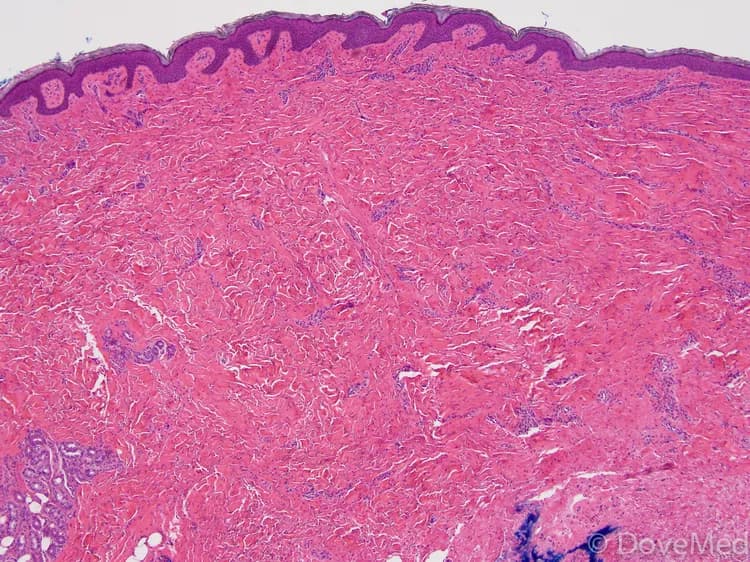What are the other Names for this Condition? (Also known as/Synonyms)
- Localized Fibrosing Disorder due to Linear Scleroderma
What is Localized Linear Scleroderma? (Definition/Background Information)
- Localized Linear Scleroderma is a condition typically found on the limb or face of a child or young adult; it can affect one or both limbs
- Scleroderma is a chronic connective tissue disorder of unknown cause. Connective tissues give support to the organs and skin. Individuals with Scleroderma have thick or hard connective tissue
There is currently a debate about how Scleroderma should be classified. A majority believe that it should be classified as an autoimmune rheumatologic disorder. Due to this, many researchers believe that the damage is caused by immune cells mistakenly attacking one’s own healthy tissue.
Scleroderma can be classified into 2 broad categories, which include Localized Scleroderma and Systemic Scleroderma:
- Localized Scleroderma:
- It often affects the skin tissues and does not cause harm to the other major organs
- There are two types of Localized Scleroderma, namely Morphea and Localized Linear Scleroderma
- Systemic Scleroderma:
- It affects the skin, tissue beneath the skin, major organs, and blood vessels
- Systemic Scleroderma also has 2 different types, namely Limited Systemic Scleroderma and Diffuse Systemic Scleroderma
- Localized Scleroderma:
Localized Linear Scleroderma is a type of Localized Scleroderma of unknown cause.
- In this disorder, a hardened line of skin can occur in any part of the body; however, the more common areas include the arms, legs, and forehead. When this hardened line occurs on the face it is called “en coup de sabre”. This term reflects the appearance of the lesion to an old-healed blow from a saber. The signs and symptoms do not progress in a rapid manner and can vary greatly from individual to individual
- The complications of Localized Linear Scleroderma include tightening of facial skin to a great degree causing the nearby functional areas, such as the mouth, to become narrower and smaller or restriction of movement of a limb
- There is currently no cure for Localized Linear Scleroderma, but medications and therapy may be used to control symptoms and prevent complications
- The prognosis of Localized Linear Scleroderma is usually excellent, as it is a localized form of Scleroderma. Individuals with this form of Scleroderma do not present the involvement of other organs, other than skin
Who gets Localized Linear Scleroderma? (Age and Sex Distribution)
- Individuals of any age can be affected by Scleroderma; however, this connective tissue disorder usually occurs from ages 25 to 55
- A majority of Localized Scleroderma cases appear before age 40. Nevertheless, children are most often affected by Localized Linear Scleroderma
- Like Scleroderma, it is thought that Localized Linear Scleroderma occurs more often in females
- Scleroderma is known to occur worldwide, in all races and ethnic groups. Localized Scleroderma is more common in individuals of European descent than African Americans
What are the Risk Factors for Localized Linear Scleroderma? (Predisposing Factors)
The risk factors for Localized Linear Scleroderma may include:
- Gender: Females are more likely than males to have Localized Linear Scleroderma
- Some studies have shown that individuals who have worked with or been exposed to silica dust and polyvinyl chloride (PVC) may have an increased incidence for the condition
It is important to note that having a risk factor does not mean that one will get the condition. A risk factor increases ones chances of getting a condition compared to an individual without the risk factors. Some risk factors are more important than others.
Also, not having a risk factor does not mean that an individual will not get the condition. It is always important to discuss the effect of risk factors with your healthcare provider.
What are the Causes of Localized Linear Scleroderma? (Etiology)
The exact cause of Localized Linear Scleroderma is presently unknown. It is thought to occur due to genetics. Research is being currently performed to identify the relevant causal factors.
- Many researchers believe that Scleroderma is an autoimmune disorder, where the body’s immune system mistakenly attacks healthy tissues resulting in damage of the tissues and organs
- Some studies have revealed that there may be a higher risk for the condition, due to occupational exposure to chemicals such as silica dust and PVC
However, research has established the following on Localized Linear Scleroderma:
- It is not an infectious or contagious condition, which means that it cannot be passed on from one individual to another through contact. It is also not a malignant condition
- It is not a genetic disorder, which means it cannot be transmitted to the children of an individual diagnosed with Localized Linear Scleroderma
What are the Signs and Symptoms?
The signs and symptoms of Localized Linear Scleroderma can vary greatly from individual to individual. This might create confusion in many, since one may not have all of the signs and symptoms described for the condition. In some cases, Localized Linear Scleroderma can be severe, causing significant signs, symptoms, and complications.
The signs and symptoms of Localized Linear Scleroderma can include:
- Hardening and tightening of the skin in a line formation that can occur in any part of the body, but commonly seen on the arms, legs, and forehead. This can cause restricted movement of the affected area of the skin
- Irregular pigmentation of skin
- Joint pain and painful joint movement; restricted movement of the joints
- Ulcer formation on the fingertips or toes
How is Localized Linear Scleroderma Diagnosed?
Localized Linear Scleroderma can be difficult to diagnose, as other conditions may have similar signs and symptoms. The presence of common symptoms or skin that thickens quickly makes it easier to diagnose Localized Linear Scleroderma.
The following tests and procedures may be used to diagnose Localized Linear Scleroderma:
- A thorough physical examination along with a complete medical and family history
- Blood tests, such as anti-nuclear antibody (ANA) panel, erythrocyte sedimentation rate (ESR), complete blood count (CBC), rheumatoid factor (RF) levels, antibody testing for other autoimmune disorders, and other tests
- Kidney function tests including creatine level, BUN level, glomerular filtration rate (GFR), and urine analysis
- Chest X-ray and CT scan of the lungs to determine the extent of lung scarring (pulmonary fibrosis)
- Pulmonary function test (PFT)
- Electrocardiogram and echocardiogram to determine the extent of heart involvement caused by heart scarring (cardiac fibrosis)
- Skin biopsy: Cells and tissues are examined by a pathologist under a microscope. Pathological examination is generally considered to be a ‘gold standard’ for a definitive diagnosis. The pathologist arrives at a diagnosis after analyzing pathology findings along with clinical information of the patient. A pathologist may perform special studies on tissue samples to aid in the final diagnosis
Even though Limited Scleroderma types have local signs and symptoms, the physician may request additional tests to rule-out systemic forms of Scleroderma.
Many clinical conditions may have similar signs and symptoms. Your healthcare provider may perform additional tests to rule out other clinical conditions to arrive at a definitive diagnosis.
What are the possible Complications of Localized Linear Scleroderma?
Complications due to Localized Linear Scleroderma can range from mild to severe and could include:
- The thickened skin, especially on an arm or leg, can cause poor limb growth in a growing child. This causes abnormalities in both the arms and legs including shortening of the limbs
- Tightening of the facial skin to a great degree can cause the mouth to become narrower and smaller, making it difficult to clean the teeth. It is common for individuals with Localized Linear Scleroderma involving the area of the oral cavity to produce inadequate amounts of saliva, which also increases the risk for dental decay
How is Localized Linear Scleroderma Treated?
Currently, Scleroderma is a condition that has no cure, but is managed through medications, lifestyle modifications, therapy, and surgery. These measures can help control symptoms and prevent complications. Localized Scleroderma can sometimes get better without treatment. The skin-related signs and symptoms of Localized Linear Scleroderma may fade on their own within 3-5 years.
The treatment options for Localized Linear Scleroderma include:
- Occupational or physical therapists can help individuals with Localized Linear Scleroderma manage pain, increase their strength, and uphold their independence in their everyday lives
- Surgery is considered to be a last resort. Amputation may be necessary in patients, whose finger ulcers have developed gangrene
Treatment measures for painful joints with or without restricted movements include:
- Regular use of sunscreen, avoiding hot showers, and regular exercising
- For individuals living in a dry climate with low humidity, the use of a humidifier can help with the signs and symptoms
- Antibiotic ointment for fingertip ulcers
- Plastic surgery may be an option for cosmetic issues; a plastic surgeon can advise on the available treatment options
- Ultraviolet light treatments are sometimes effective. There are lasers which can direct the light specifically to the area(s) of involvement
- Systemic medications used include intralesional or oral corticosteroids, phenytoin, hydroxychloroquine, cyclosporin, antibiotics, and vitamin E
- It is always important to follow the physician’s advice and take the prescribed medication regularly
- A therapist or certain support groups may be consulted on the variety of social issues that can be caused by Scleroderma, which include self-esteem issues, depression, anxiety, and relationships with friends, family, and partners
Treatment measures for dry mouth and dental issues include:
- Individuals with Localized Linear Scleroderma could experience tightening of the facial skin that may prevent adequate oral care; this can result in the development of tooth decay
- The following measures can help decrease the signs and symptoms:
- Regular brushing and flossing of teeth
- Regular dental check-ups
- Keeping mouth wet by constantly sipping water
Avoid mouthwash that contains alcohol, since alcohol in mouthwashes can cause dryness of the mouth
How can Localized Linear Scleroderma be Prevented?
Currently, there are no specific methods or guidelines to prevent Localized Linear Scleroderma. However, through proper dietary and lifestyle changes, some of the signs and symptoms may be controlled.
What is the Prognosis of Localized Linear Scleroderma? (Outcomes/Resolutions)
- The prognosis of Localized Linear Scleroderma is usually excellent, as it is a localized form of Scleroderma. Individuals with this condition do not have involvement of other organs other than the skin
- However, the manner in which Localized Linear Scleroderma changes and progresses over time varies amongst individuals. Some individuals respond well to treatment and generally have a better prognosis than those who do not respond well to treatment
Additional and Relevant Useful Information for Localized Linear Scleroderma:
- Research is currently underway to identify and understand more about Scleroderma. Studies are being completed to understand the genes that may be involved with the development of the condition and to find medicines to completely treat Localized Linear Scleroderma
- Scleroderma used to be called progressive systemic sclerosis, but this term is no longer used since Scleroderma does not always progress by nature. This means that the signs and symptoms do not progress with equal severity in all individuals
Related Articles
Test Your Knowledge
Asked by users
Related Centers
Related Specialties
Related Physicians
Related Procedures
Related Resources
Join DoveHubs
and connect with fellow professionals



0 Comments
Please log in to post a comment.